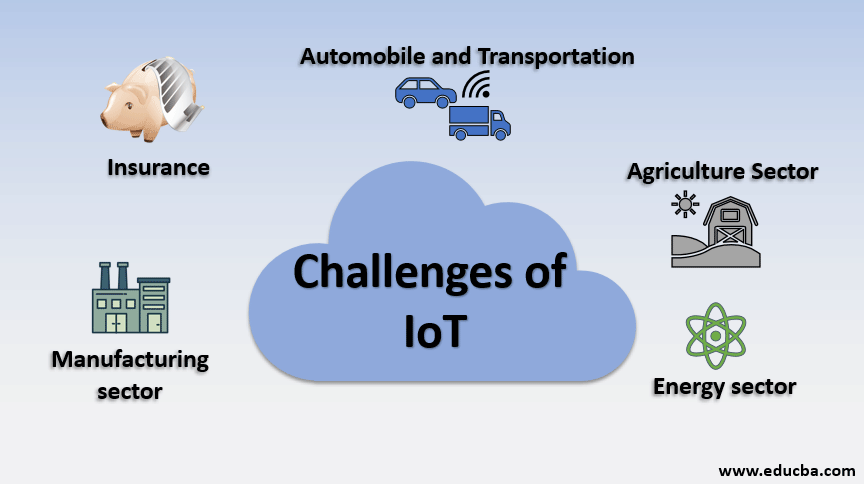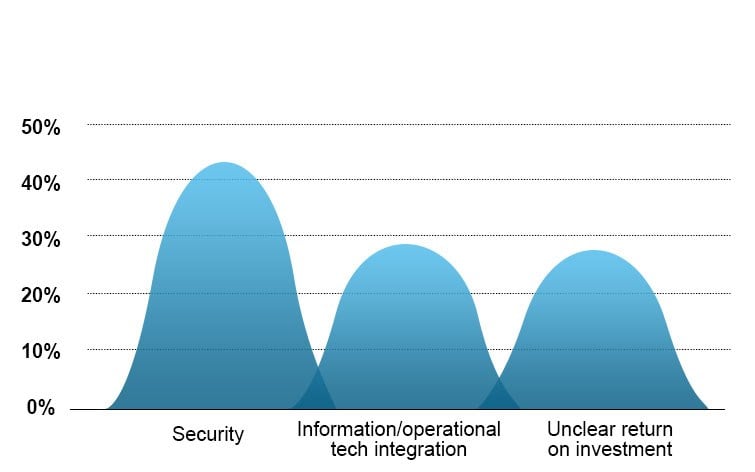Updated March 21, 2023
Introduction to Challenges IoT Implementations
Internet of Things (IoT) is a technology-based on connected smart device that has the potential to change the industry landscape in scale. In the era of cheap computing resources, unlimited bandwidth, and 24/7 connected devices, IoT range across all industries from agriculture to space. As per the recent IDC(International Data Corporation) forecast, the worldwide spending of IoT for 2019 will cross $745 billion, which is 15.4% more than the previous year. It is expected that global spending will cross the $1 trillion mark by the end of 2020-2022. Like every innovation in history, IoT has also been going through its own set of challenges. In this article, we will discuss the implementation and negative challenges faced by Industrial IoT solutions.
Industry-wise IoT use cases and their challenges
Let discuss how incorporated IoT solutions has been facing challenges across the industry landscape.
1. Challenges in the Manufacturing sector
Smart sensory data are used to prevent abnormal breakdowns, requirement analysis, and resource optimization.IIoT solutions help organizations in smart asset management, performance monitoring, which reduces asset downtime and increases hardware legibility.
Maintenance of IoT sensors and preprocessing of large-scale unstructured data is always a pain for IoT use cases in this sector. Also, determining the proper use case and developing proper IoT infrastructure, defining the scope and KPI will be among the topmost challenges needed to be addressed.
2. Challenges in Agriculture Sector
IoT is thought of as the greatest change agent in the agriculture industry for upcoming years. As per researchers, IoT probably will be the most powerful weapon for the agriculture and farming industry to fight with environmental change, huge demand-supply gap and need for human interventions. IoT enables farm managers with real-time corp monitoring, precision farming, livestock management, smart greenhouse management, etc.
Unfortunately, the rate of attrition of the workforce from agriculture to other sectors is too high. In contrast to other sectors, installing and maintaining IoT devices are a bit tricky and require lots of investment.
3. Challenges in Insurance
IIoT solutions can be used for automated claims processing as a factor of premium calculation, automated reserve setting, damage assessment, etc.
The main challenge facing by the IIoT use cases in Insurance is that, as an industry, it requires a higher level of privacy and data governance. Insurance organizations are still hardly ready to share data for analytics use cases.
4. Challenges in Automobile and Transportation
In the era of cheap internet and connected devices, upgrades can be made on-demand. Modern cars are equipped with IoT-based smart sensors that help in real-time car tracking, speed control, fuel consumption control, car renting solutions, etc. IoT and deep learning help in developing automated parking systems, semi autopilots, and even self-driving cars.
Maintaining safety and privacy benchmarks are the main challenges in the automobile sector. The data is vulnerable to interruption and coordinated malware attacks from the hardware endpoint to the analysis center and blockchains. Proper data governance and firewalls are essential to overcome the challenges.
5. Challenges in the Energy sector
IIoT solutions can bring changes in energy sectors with valuable insights on power consumption, hardware maintenance, forecasting dynamic pricing, etc.
Traditionally Energy and Power sectors are considered as sectors with unstructured data. Deploying the right set of hardware, acquiring and managing the huge data, preprocessing and gaining valuable insights will be the key challenges to incorporate IoT solutions in the energy sector.
Common challenges
Along with the domain-specific challenges, there are some common constraints across the industry.
- Difference between expectations and reality: For a lot of Industries, IoT is still in its early phase; there is a gap between what is expected from IoT and what is feasible. Organizational data maturity deals with the main role here.
- Lack of properly defined use cases: In a large number of cases, the scope and end expectation of a use case is ill-defined. This leads to a failed use case without any business value.
- Enforcing security measures and data governance: Managing huge data and ensuring privacy and proper security measures is a big challenge of incorporating IoT solutions. Suppose you are using an automatic or semi-automatic car. Now, if the automotive IoT infrastructure is compromised, it will lead to real threats.
- Changed business model: Together, IoT and analytics based on connected devices are changing the business capabilities and delivery model. Finding resources with the right skill sets and set the course accordingly is a challenge for businesses.
Below are the Allocadia report on challenges faced by incorporating IoT solutions in the industry
Source: Allocadia report, 2017
Conclusion
In this article, we discussed the generic and Industry-specific constraints to incorporate IoT solutions. We have also learned about the various factors like privacy and security concerns, technical and business challenges, scope and ROI of the use cases, etc. As per expert predictions, IoT will overcome the early challenges by 2022, and by 2025 it will be almost everywhere.
Recommended Articles
This is a guide to the Challenges of IoT. Here we discuss the challenges of IoT, Industry-wise IoT use cases and their challenges, and the Common Challenges in IoT. You can also go through our other suggested articles to learn more –


